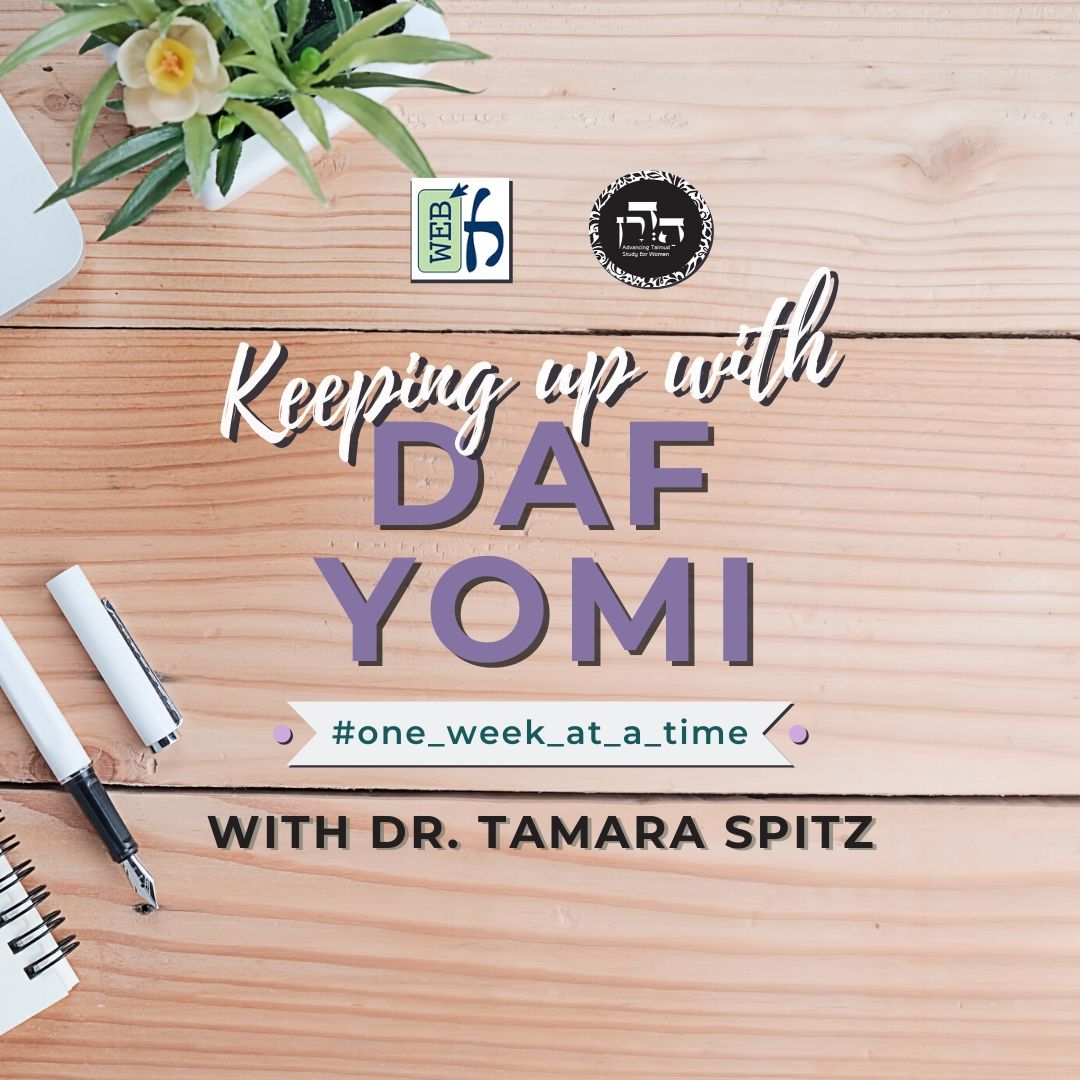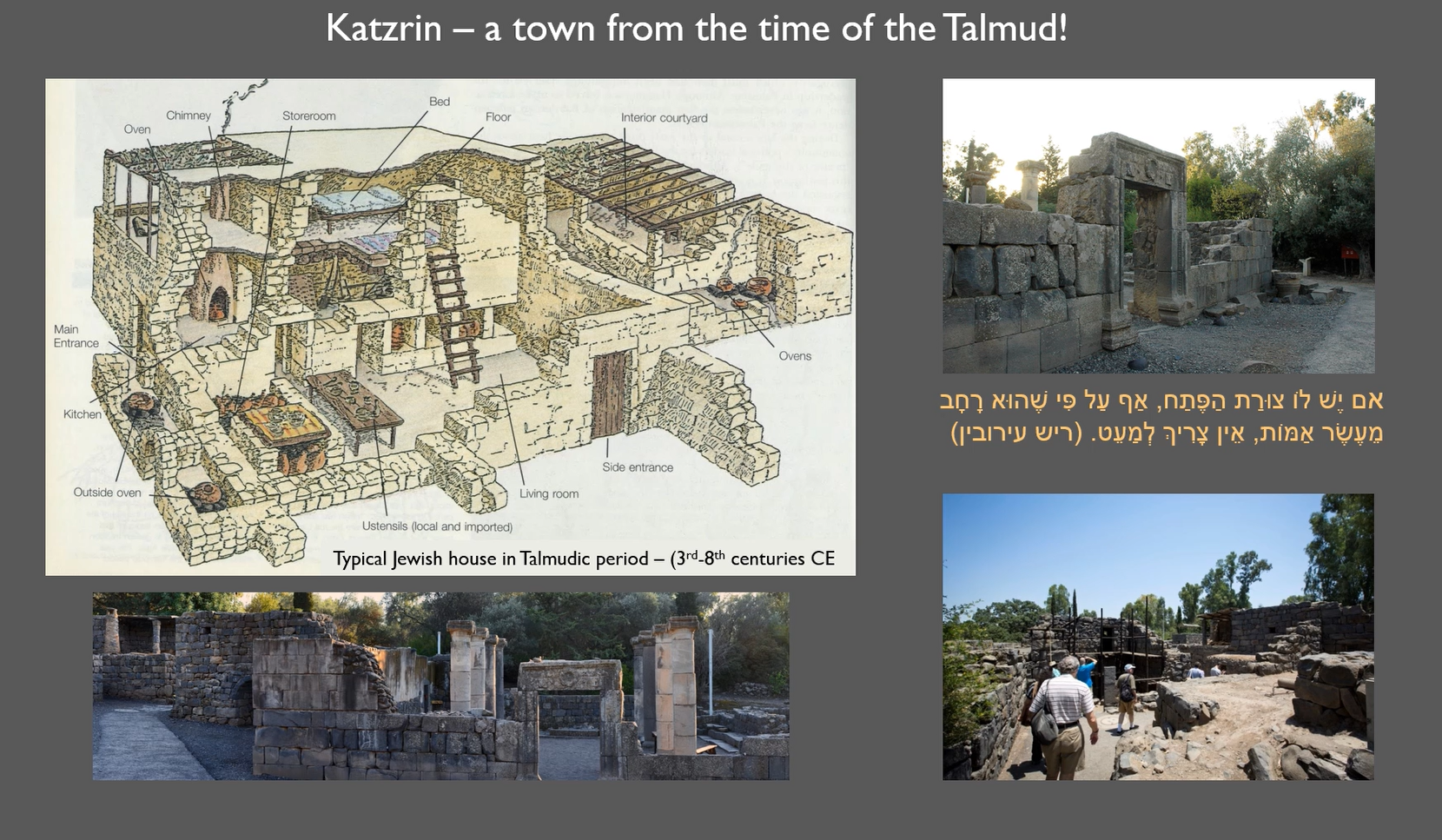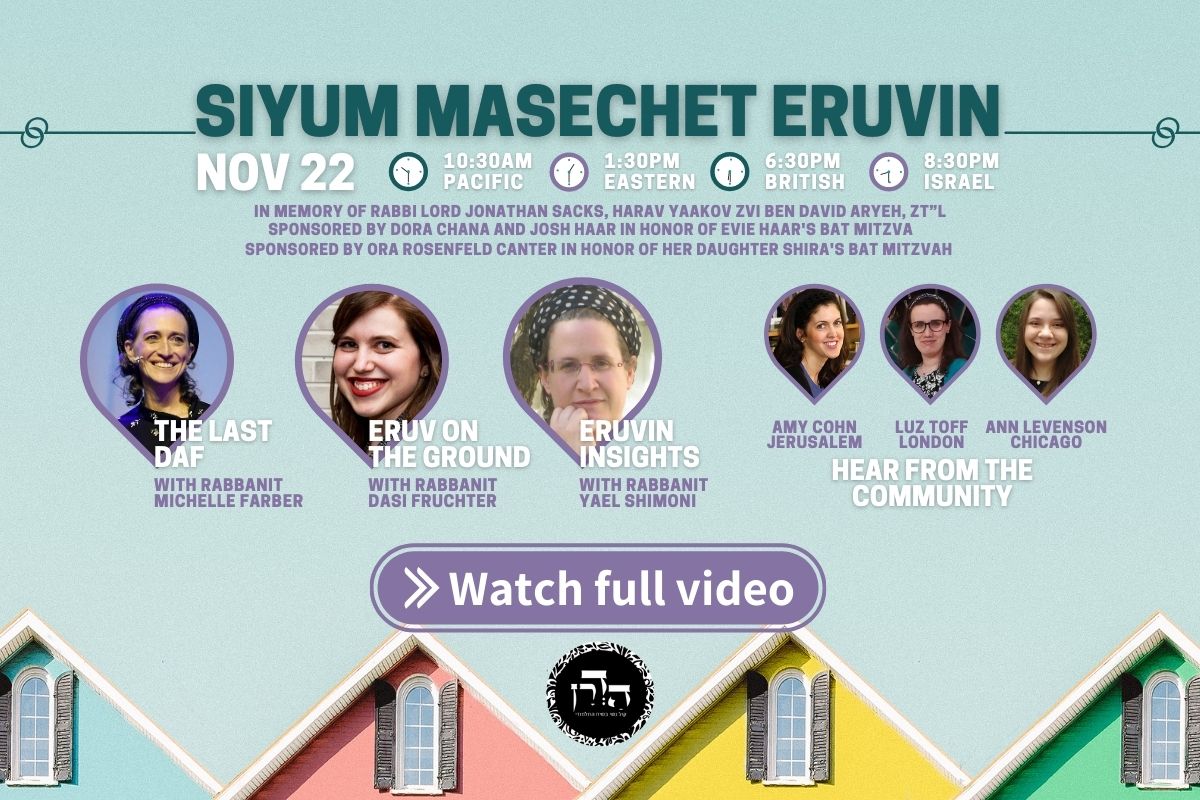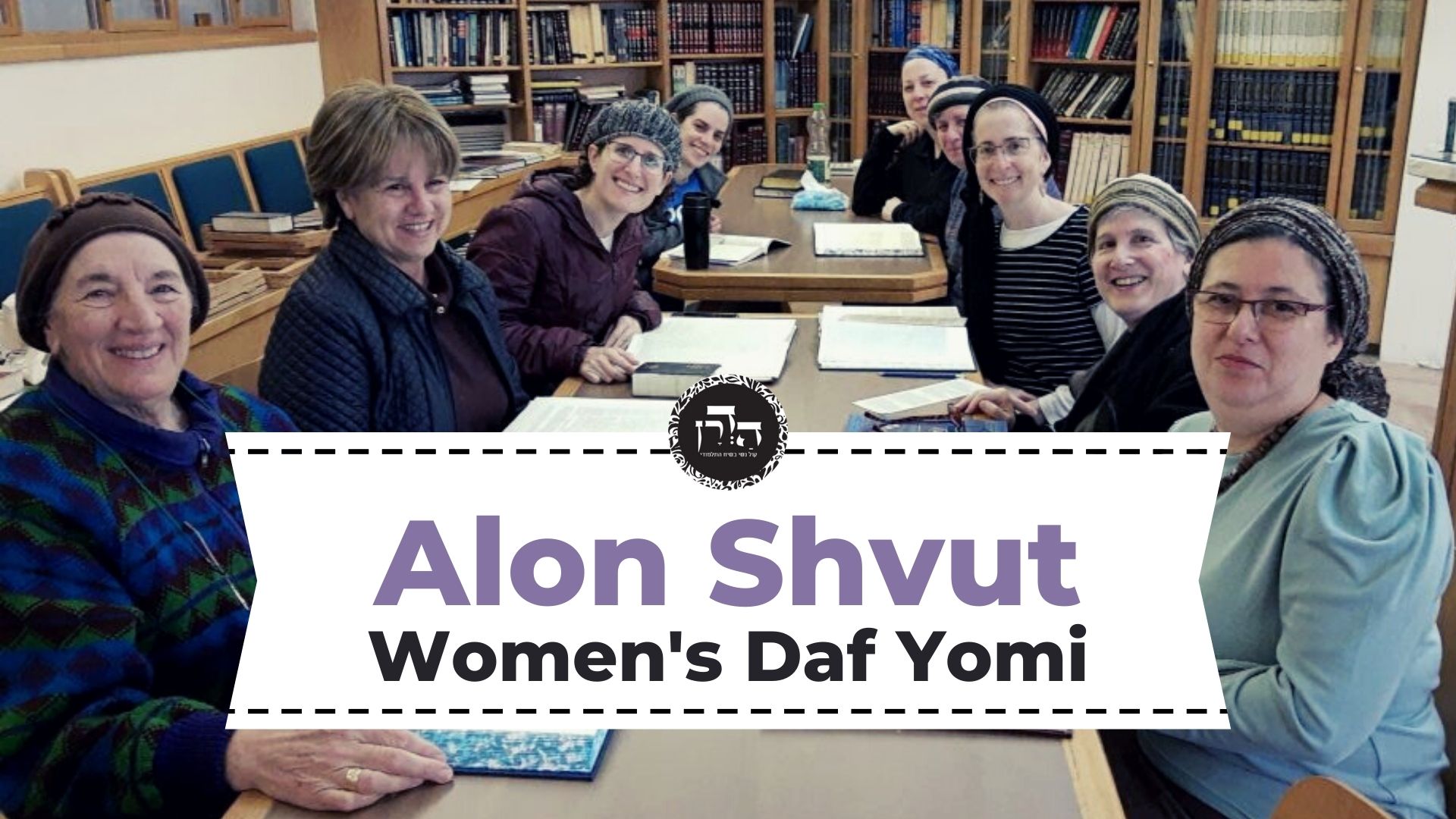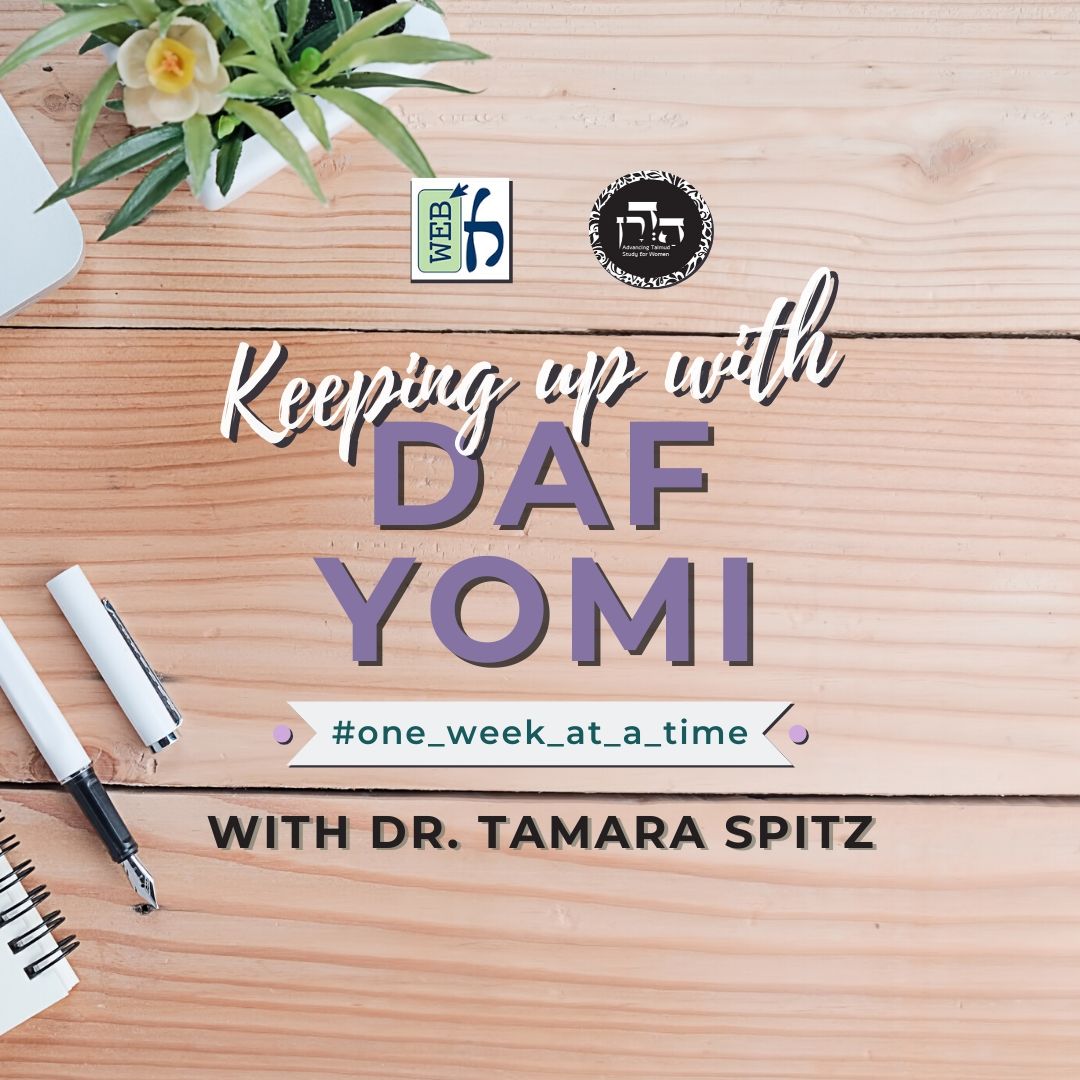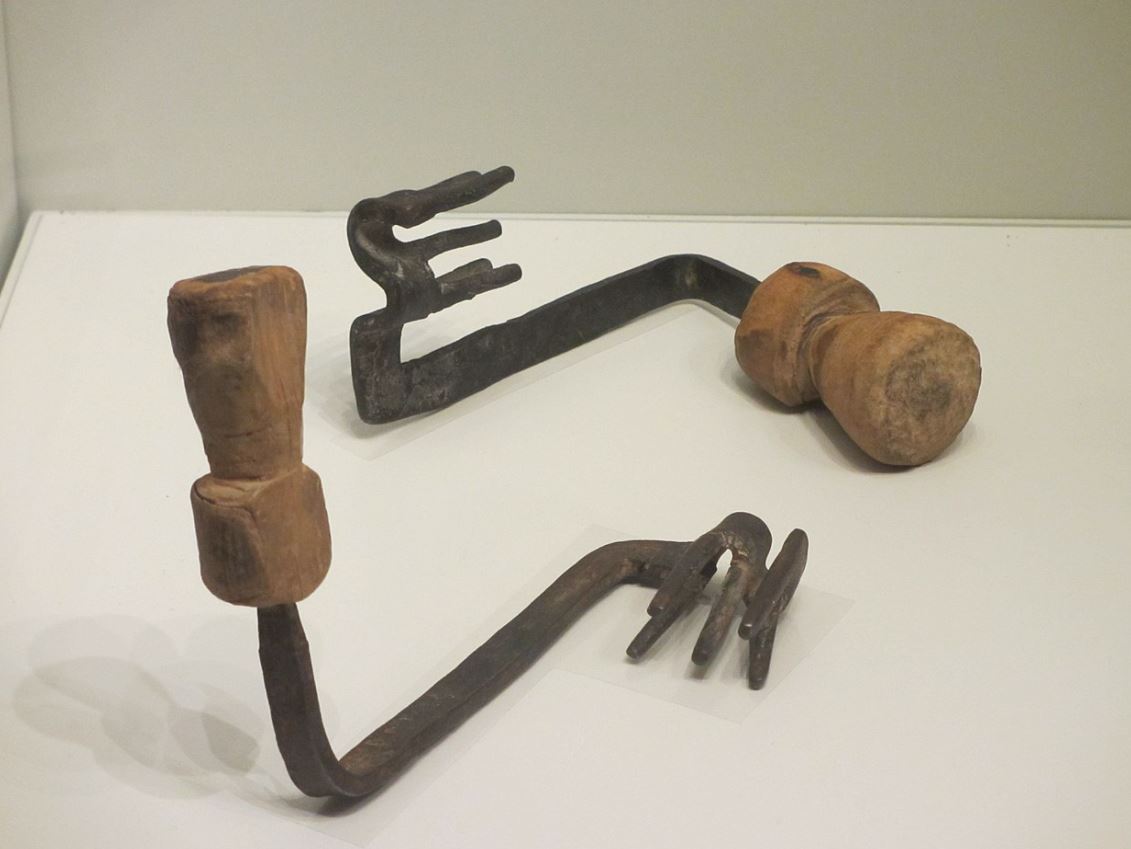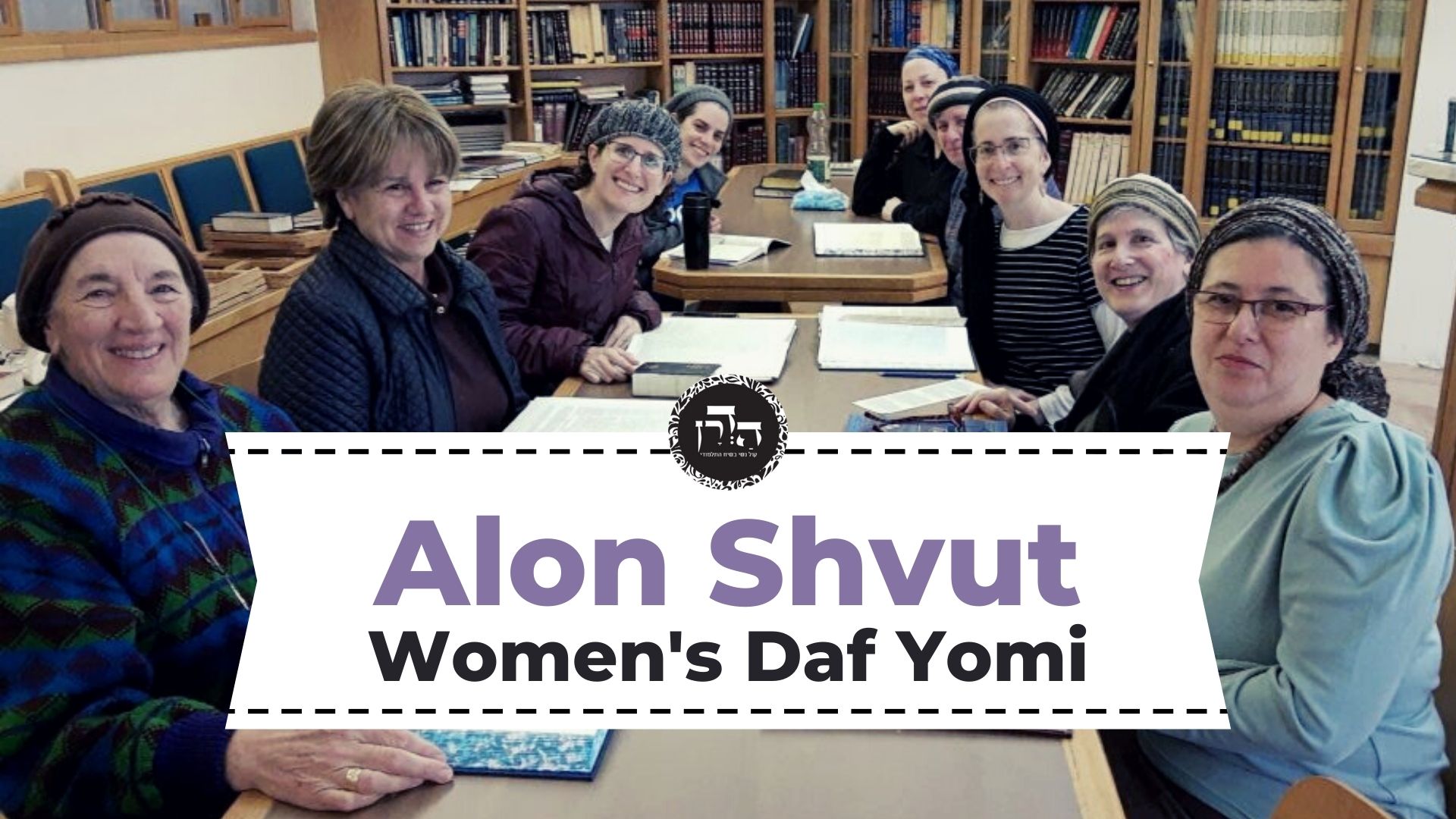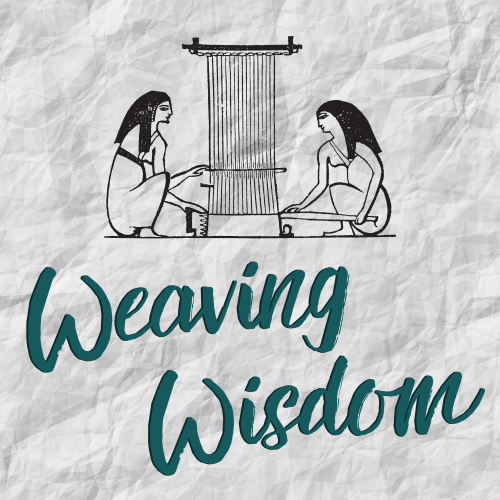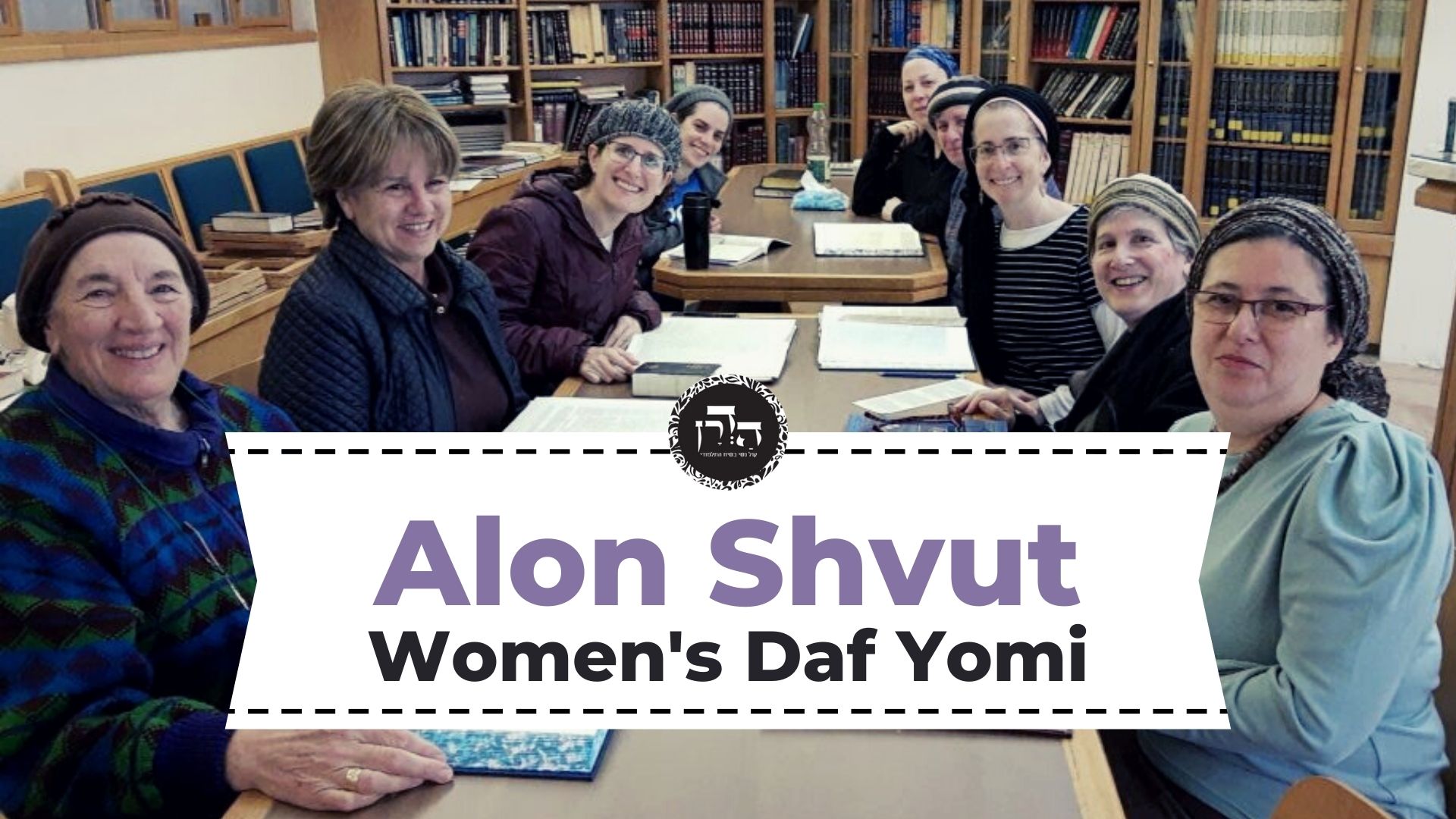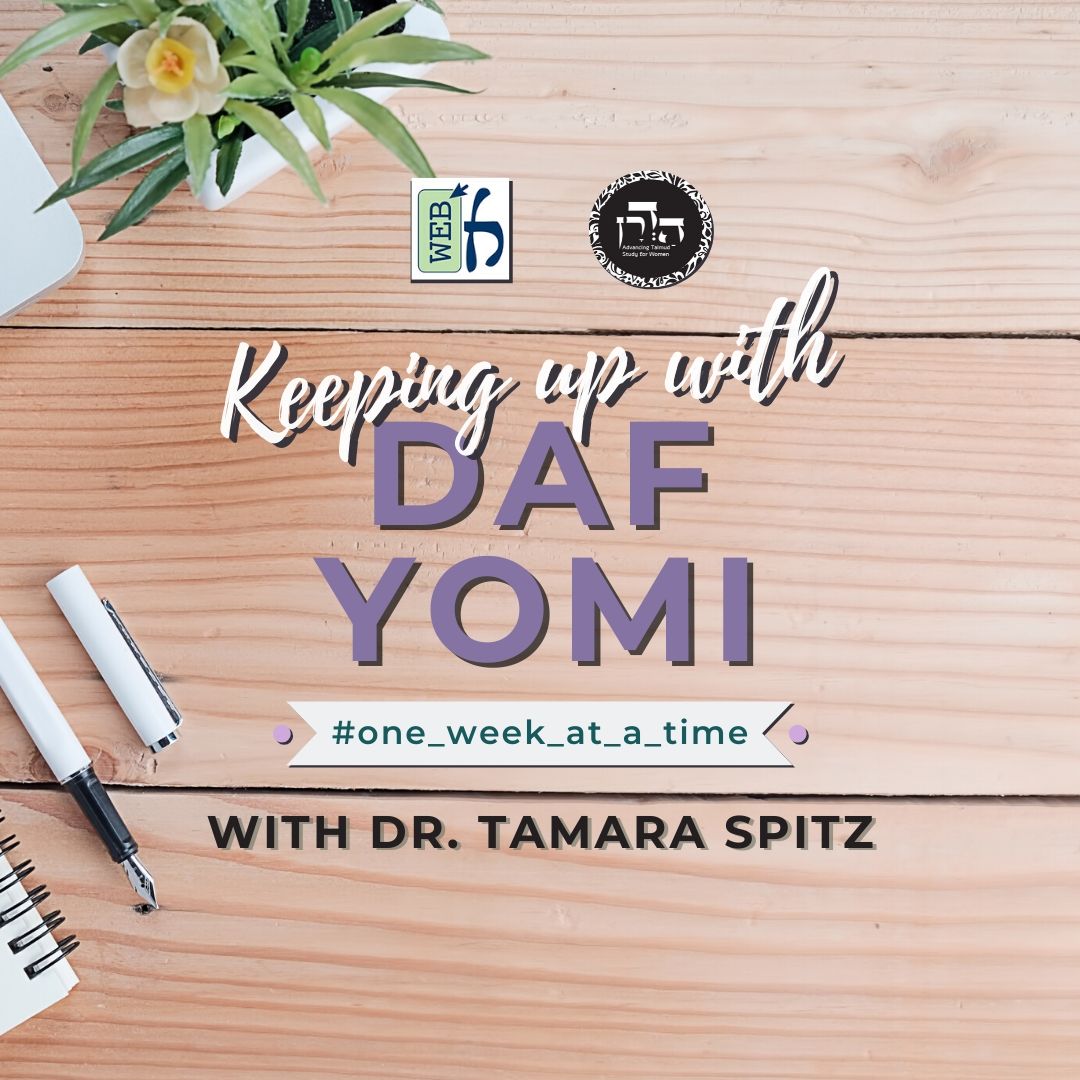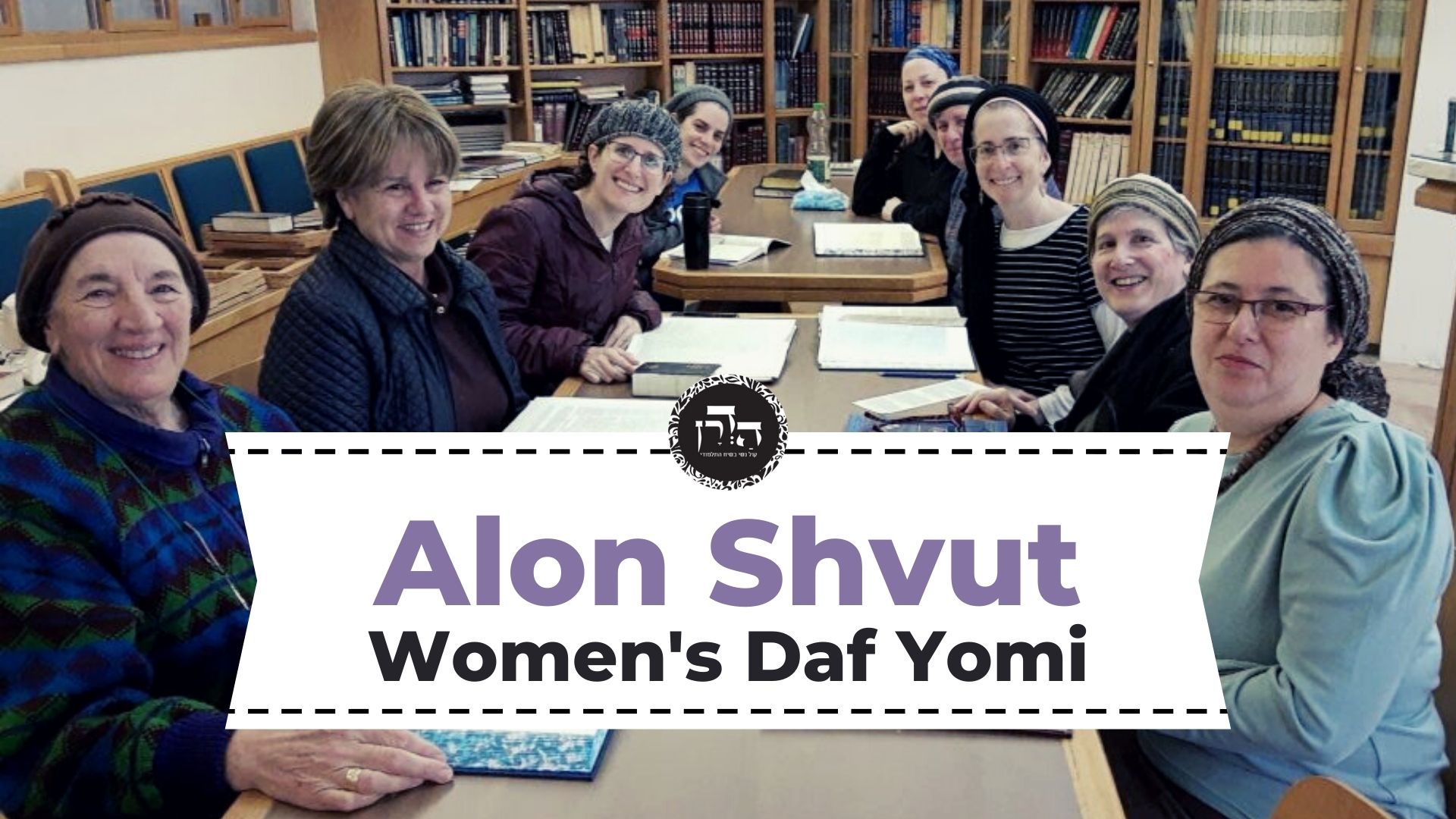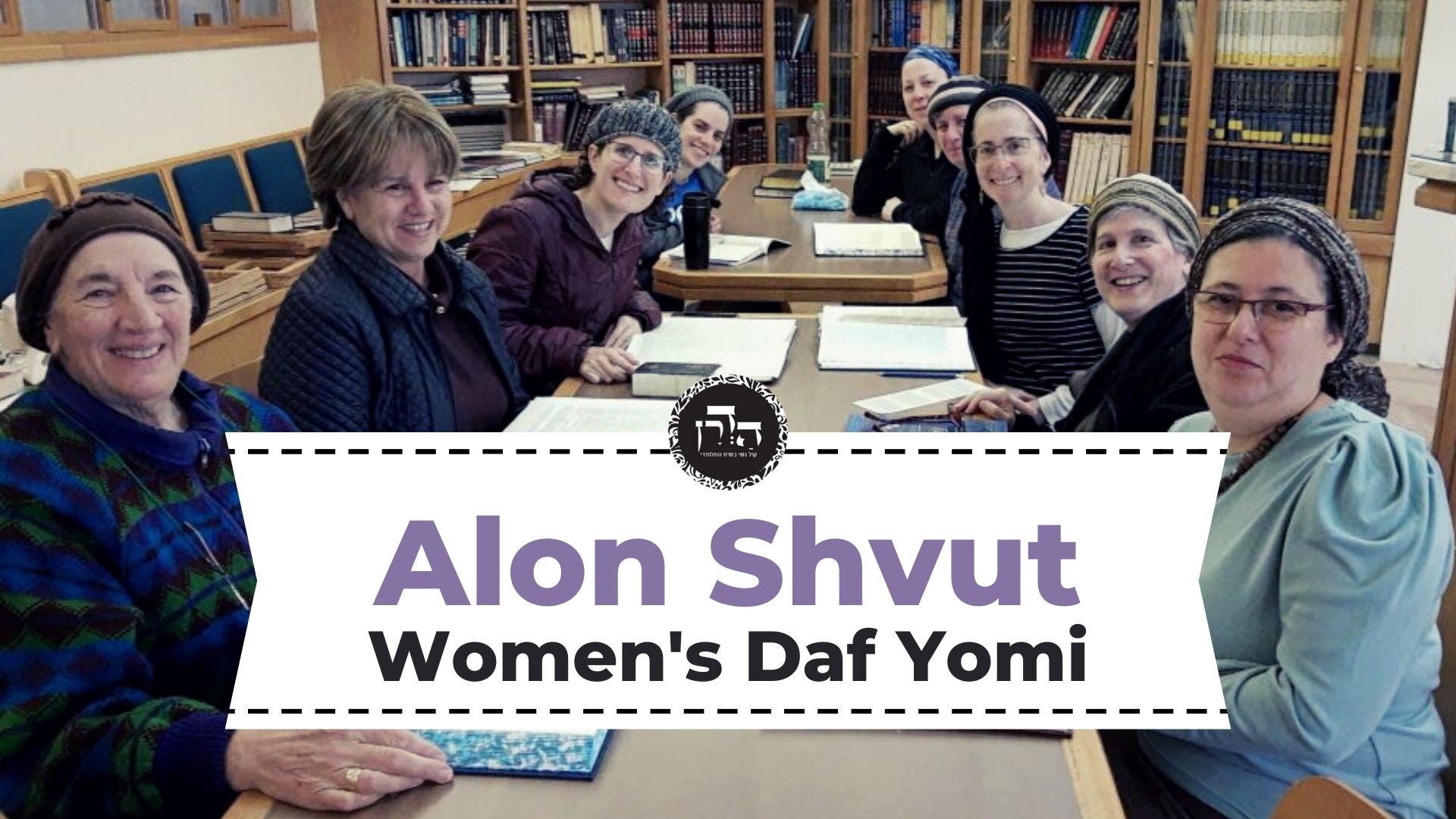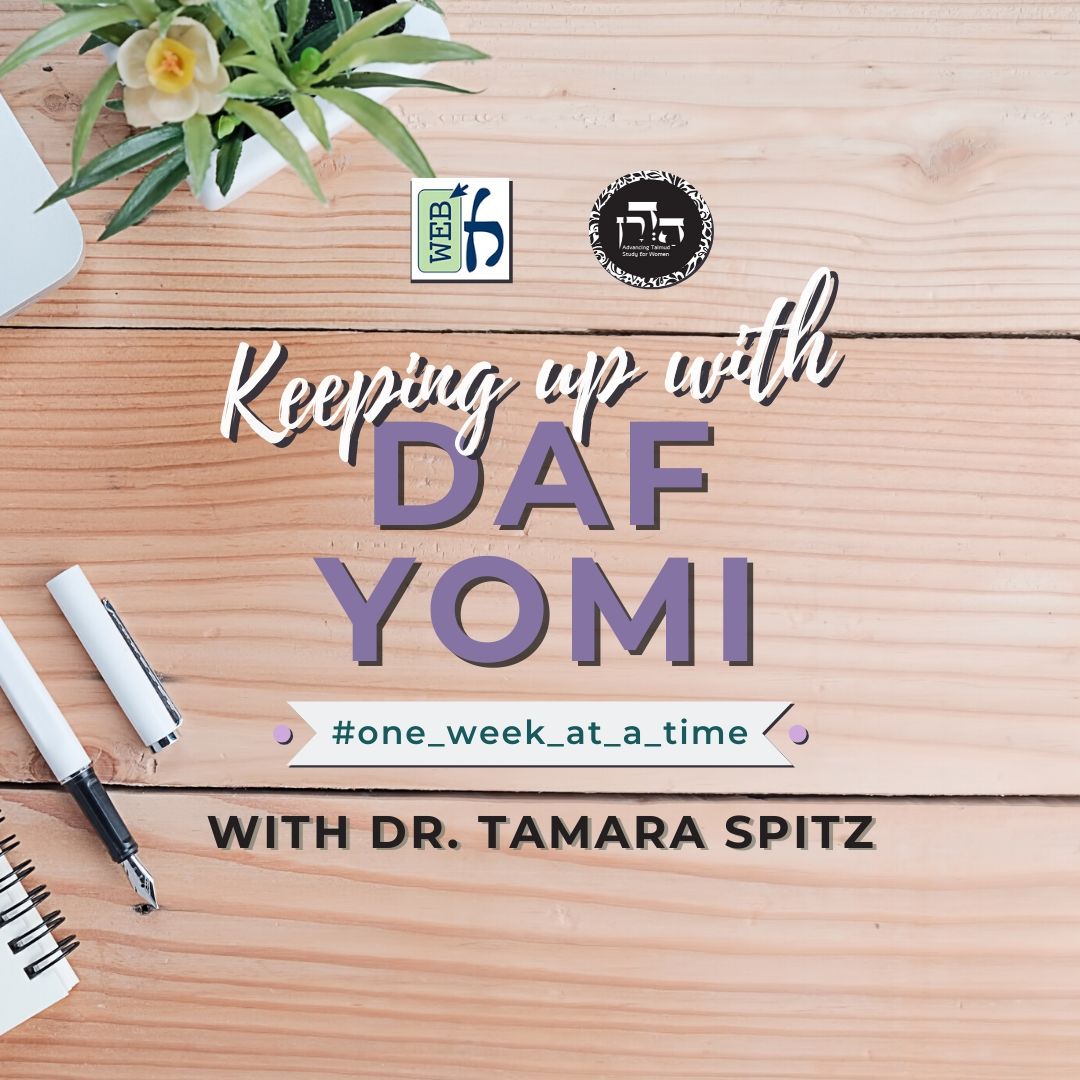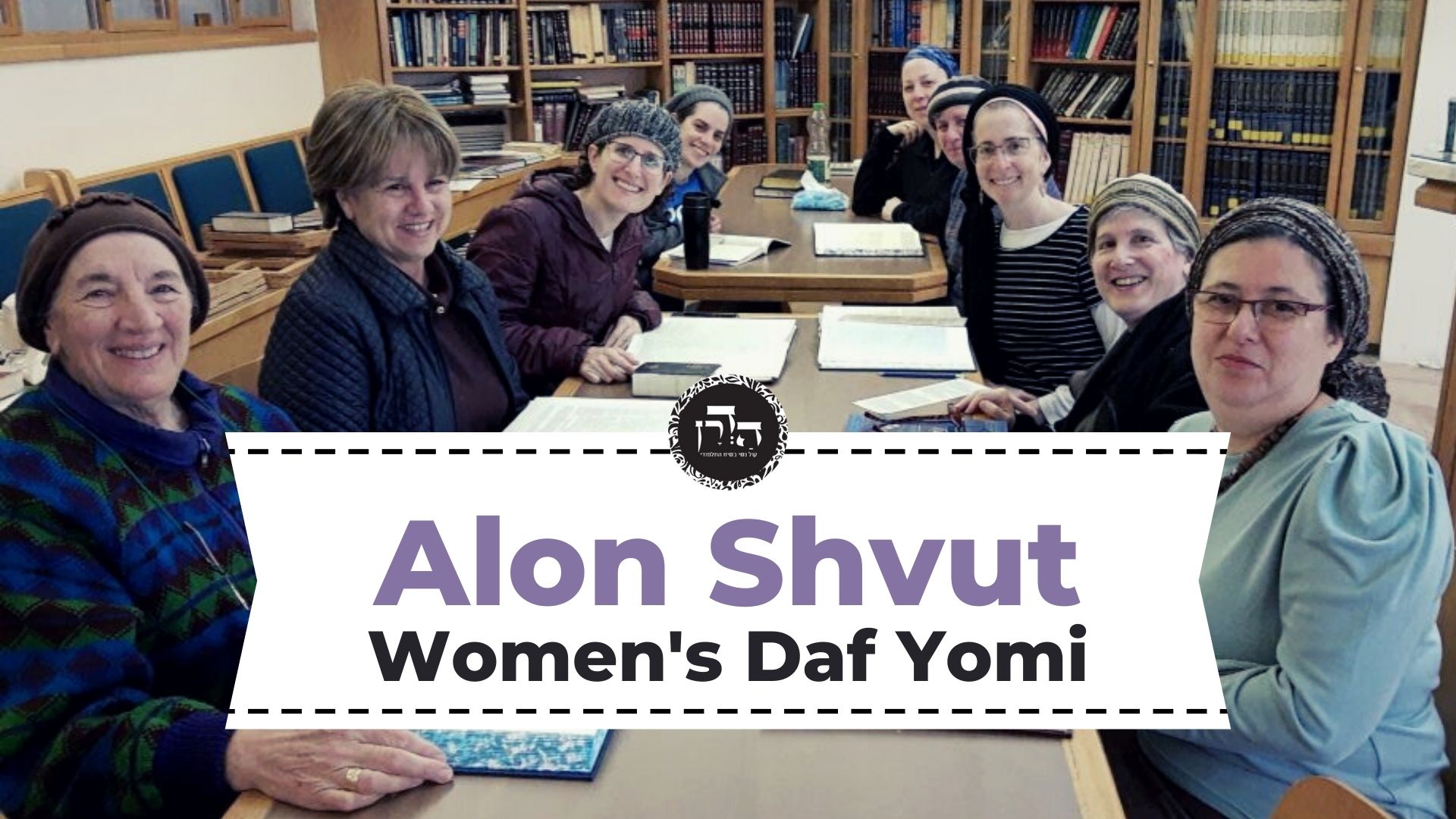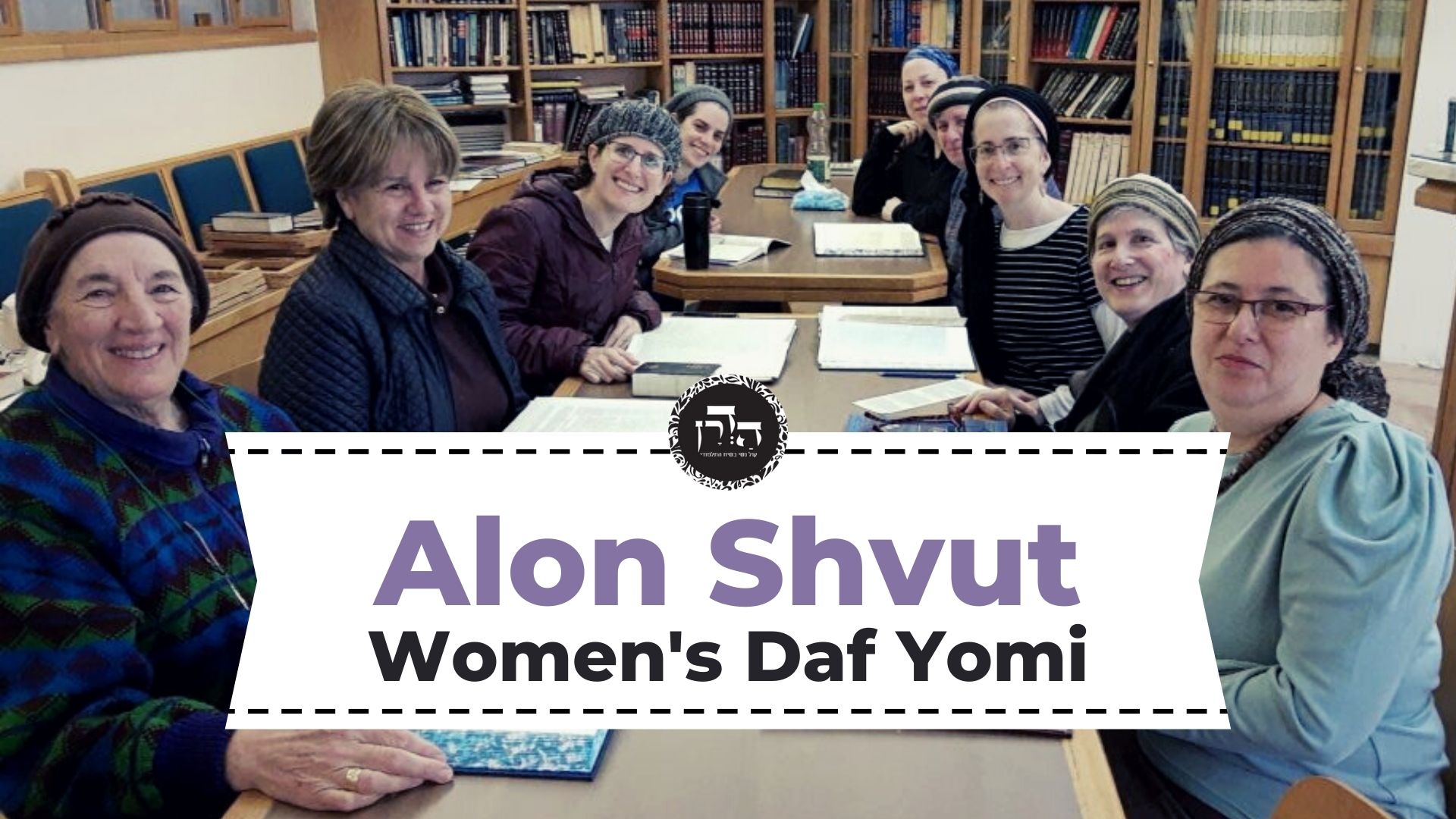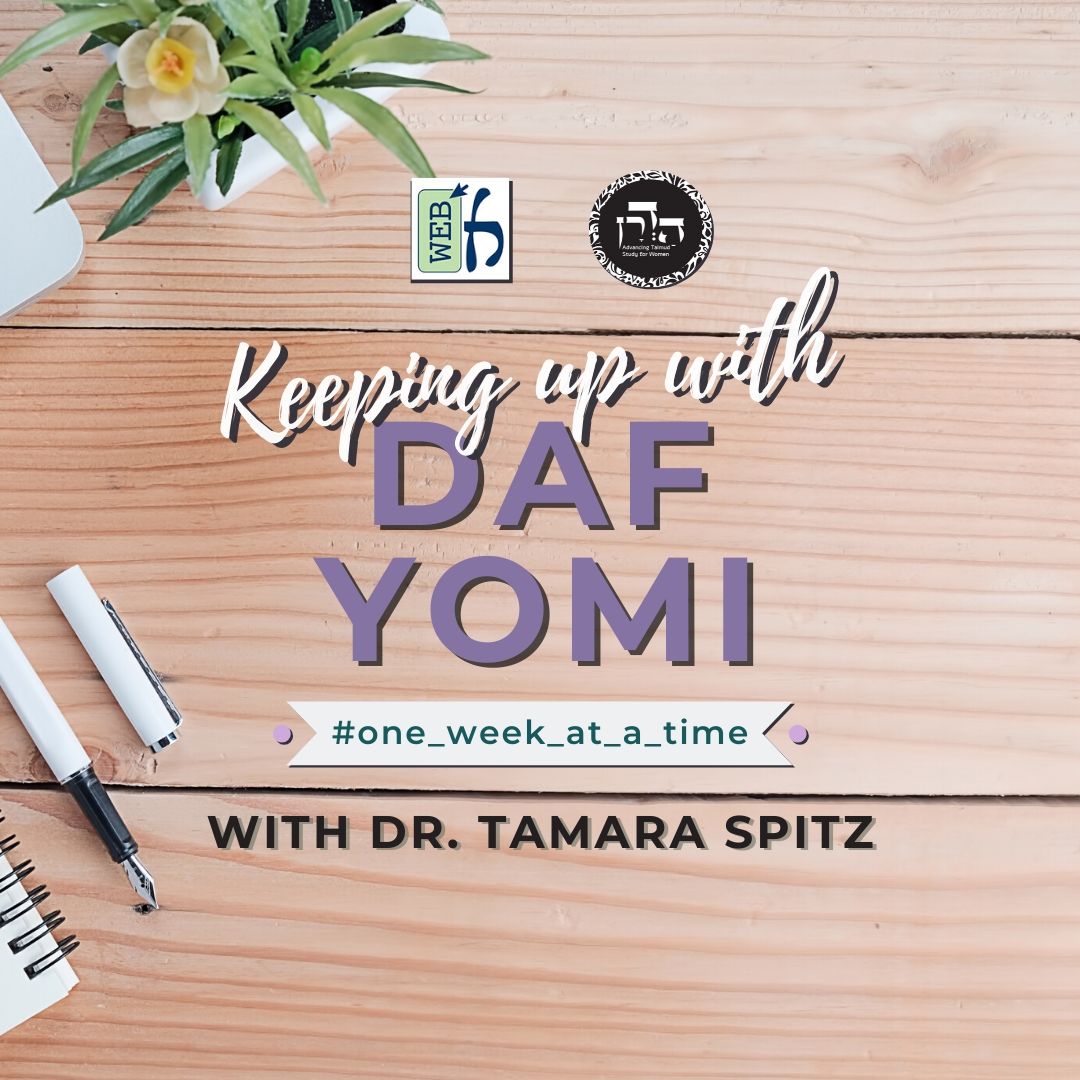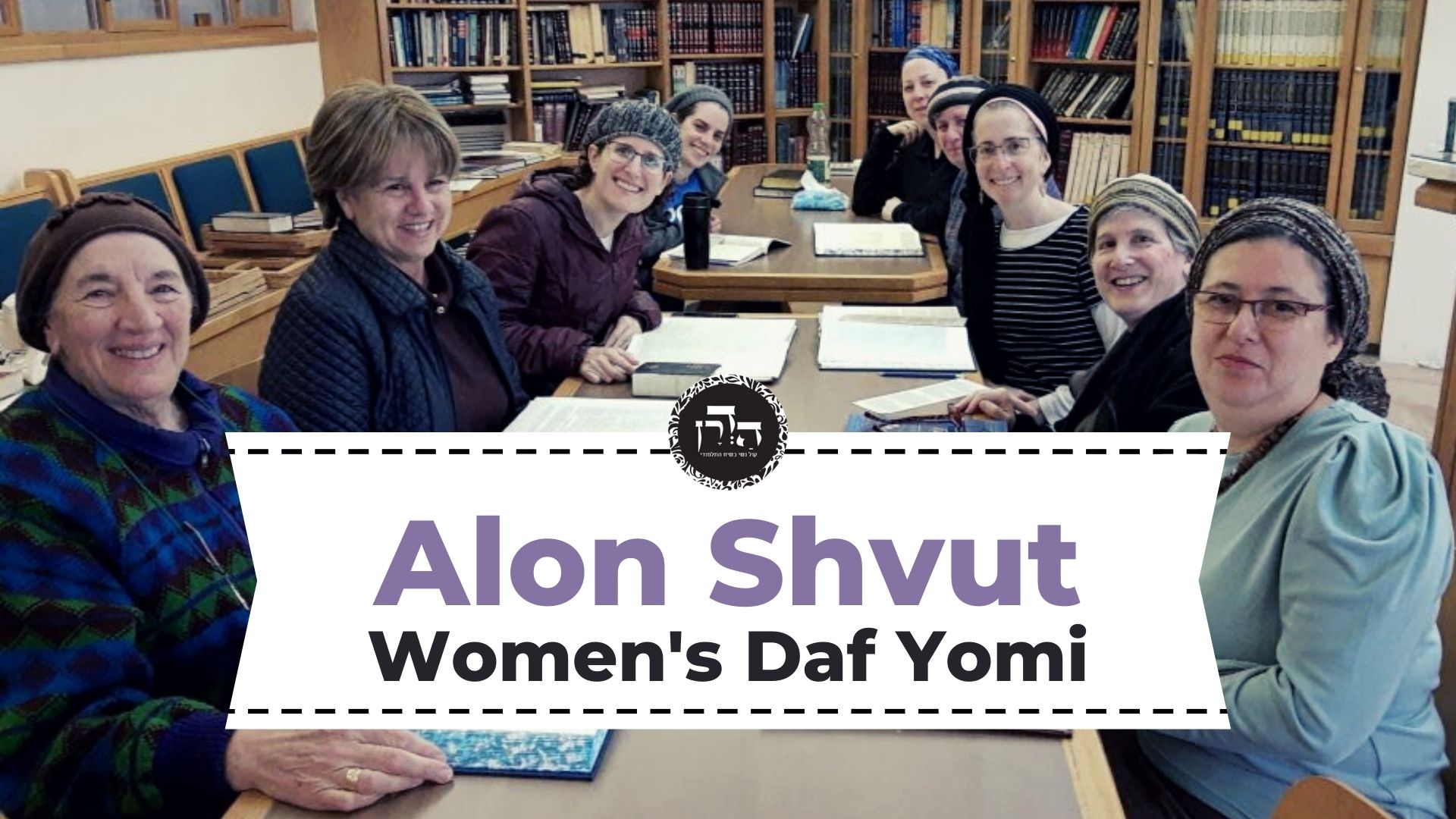Eruvin 94
זֶה מְטַלְטֵל עַד עִיקַּר מְחִיצָה, וְזֶה מְטַלְטֵל עַד עִיקַּר מְחִיצָה.
This one may carry to the base of the former partition, and that one may likewise carry to the base of the partition, as he maintains that since it was permitted at the beginning of Shabbat, it remains permitted until the conclusion of Shabbat.
וְהָא דְּרַב לָאו בְּפֵירוּשׁ אִתְּמַר, אֶלָּא מִכְּלָלָא אִתְּמַר. דְּרַב וּשְׁמוּאֵל הֲווֹ יָתְבִי בְּהָהוּא חָצֵר, נְפַל גּוּדָּא דְּבֵינֵי בֵּינֵי, אֲמַר לְהוּ שְׁמוּאֵל: שְׁקוּלוּ גְּלִימָא, נְגִידוּ בַּהּ.
The Gemara comments: And this ruling of Rav was not stated explicitly; rather, it was stated by inference; i.e., it was inferred by his students from another one of his teachings. As once Rav and Shmuel were sitting in a certain courtyard on Shabbat, and the wall between the two courtyards fell. Shmuel said to the people around him: Take a cloak and suspend it on the remnant of the partition.
אַהְדְּרִינְהוּ רַב לְאַפֵּיהּ. אֲמַר לְהוּ שְׁמוּאֵל: אִי קָפֵיד אַבָּא, שְׁקוּלוּ הֶמְיָינֵיהּ וּקְטַרוּ בָּהּ.
Rav turned his face away, displaying his displeasure with Shmuel’s opinion, as Rav maintained it was prohibited to carry a cloak in this courtyard. Shmuel said to them in a humorous vein: If Abba, Rav, is particular, take his belt and tie it to the cloak, to secure it to the partition.
וְלִשְׁמוּאֵל לְמָה לִי הָא? הָא אָמַר: זֶה מְטַלְטֵל עַד עִיקַּר מְחִיצָה וְזֶה מְטַלְטֵל עַד עִיקַּר מְחִיצָה!
The Gemara asks: And according to Shmuel, why was it necessary to suspend the cloak? He himself said: If a wall between two courtyards collapsed on Shabbat, this one may carry to the base of the former partition, and that one may likewise carry to the base of the partition.
שְׁמוּאֵל עָבֵיד לִצְנִיעוּתָא בְּעָלְמָא.
The Gemara answers: Shmuel did not do so to render it permitted to carry in the courtyard. He did so merely for the purpose of privacy, as he did not want the residents of the other courtyard to see into his own courtyard.
וְרַב, אִי סְבִירָא לֵיהּ דַּאֲסִיר — לֵימָא לֵיהּ! אַתְרֵיהּ דִּשְׁמוּאֵל הֲוָה.
The Gemara asks: And Rav, if he maintains that in this case carrying is prohibited, he should have said so to him explicitly. The Gemara answers: It was Shmuel’s place. Rav did not want to disagree with his colleague in his jurisdiction, as he accepted the opinion of the local authority.
אִי הָכִי, מַאי טַעְמָא אַהְדְּרִינְהוּ לְאַפֵּיהּ? דְּלָא נֵימְרוּ כִּשְׁמוּאֵל סְבִירָא לֵיהּ (וַהֲדַר בֵּיהּ מִשְּׁמַעְתֵּיהּ).
The Gemara asks: If so, if he accepted the jurisdiction of the local rabbinic authority, why did he turn his face away? The Gemara answers: He acted in this manner so that people would not say that he holds in accordance with the opinion of Shmuel, and that he retracted his opinion with regard to this halakha.
מַתְנִי׳ חָצֵר שֶׁנִּפְרְצָה לִרְשׁוּת הָרַבִּים — הַמַּכְנִיס מִתּוֹכָהּ לִרְשׁוּת הַיָּחִיד, אוֹ מֵרְשׁוּת הַיָּחִיד לְתוֹכָהּ — חַיָּיב, דִּבְרֵי רַבִּי אֱלִיעֶזֶר.
MISHNA: With regard to a courtyard that was breached into the public domain, and the breach was more than ten cubits wide, so that it cannot be considered an entrance, one who carries an object from inside the courtyard into the private domain, or from the private domain into it, is liable, as it ceases to be a private domain and is subsumed into the public domain. This is the statement of Rabbi Eliezer.
וַחֲכָמִים אוֹמְרִים: מִתּוֹכָהּ לִרְשׁוּת הָרַבִּים אוֹ מֵרְשׁוּת הָרַבִּים לְתוֹכָהּ — פָּטוּר, מִפְּנֵי שֶׁהִיא כְּכַרְמְלִית.
And the Rabbis disagree and say: One who carries from inside the courtyard into the public domain, or from the public domain into it, is exempt, because its legal status is like that of a karmelit. Although it ceases to be a private domain, it does not become a full-fledged public domain.
גְּמָ׳ וְרַבִּי אֱלִיעֶזֶר, מִשּׁוּם דְּנִפְרְצָה לִרְשׁוּת הָרַבִּים הָוְיָא לַהּ רְשׁוּת הָרַבִּים?! אִין, רַבִּי אֱלִיעֶזֶר לְטַעְמֵיהּ,
GEMARA: The Gemara asks: And according to Rabbi Eliezer, due to the fact that the courtyard was breached into the public domain, does it become the public domain? The Gemara answers: Yes, as in this regard the opinion of Rabbi Eliezer conforms to his standard line of reasoning.
דְּתַנְיָא, רַבִּי יְהוּדָה אוֹמֵר מִשּׁוּם רַבִּי אֱלִיעֶזֶר: רַבִּים שֶׁבֵּרְרוּ דֶּרֶךְ לְעַצְמָן, מַה שֶּׁבֵּרְרוּ בֵּרְרוּ.
As it was taught in a baraita that Rabbi Yehuda said in the name of Rabbi Eliezer: In a situation where the multitudes selected a path for themselves in a field, or between fields, the path that they selected, they selected, and they retain the right to traverse this path even if the place belongs to an individual. Here too, as the partition of the courtyard was breached to the extent that the public can enter, its status is that of a public domain.
אִינִי?! וְהָאָמַר רַב גִּידֵּל אָמַר רַב: וְהוּא שֶׁאָבְדָה לָהֶן דֶּרֶךְ בְּאוֹתוֹ שָׂדֶה.
The Gemara expresses surprise at this opinion: Is that so? But didn’t Rav Giddel say that Rav said: And this applies only if they had misplaced a path in that field. Generally speaking, the public does not have the right to establish a path wherever it chooses. The baraita is referring to a case where a public path used to run through that field, but it fell into disuse, and no one remembers its precise course. In this case the public may once again select a path through the field.
וְכִי תֵּימָא: הָכָא נָמֵי כְּגוֹן שֶׁאָבְדָה לָהֶן דֶּרֶךְ בְּאוֹתָהּ חָצֵר, וְהָאָמַר רַבִּי חֲנִינָא: עַד מְקוֹם מְחִיצָה מַחֲלוֹקֶת.
And if you say: Here too, the mishna is dealing with a case where the public misplaced a path in that courtyard. They do not remember the exact position of the partition that once separated the courtyard and the public domain. The public claims that the residents of the courtyard appropriated that part of their domain. It is only this area that Rabbi Eliezer says is considered a public domain. The Gemara asks: But didn’t Rabbi Ḥanina say: The dispute between Rabbi Eliezer and the Rabbis is with regard to the entire courtyard to [ad] the place of the fallen partition, not only the small section that might have been a public path.
אֵימָא: עַל מְקוֹם מְחִיצָה מַחֲלוֹקֶת.
The Gemara rejects this argument: Say that Rabbi Ḥanina stated that Rabbi Eliezer and the Rabbis disagree over [al] the place of the partition, i.e., the dispute does not concern the entire courtyard, but only the former location of the partition, where a public path might once have passed.
וְאִיבָּעֵית אֵימָא, בְּצִידֵּי רְשׁוּת הָרַבִּים קָמִיפַּלְגִי, דְּרַבִּי אֱלִיעֶזֶר סָבַר: צִידֵּי רְשׁוּת הָרַבִּים — כִּרְשׁוּת הָרַבִּים דָּמוּ, וְרַבָּנַן סָבְרִי צִידֵּי רְשׁוּת הָרַבִּים — לָאו כִּרְשׁוּת הָרַבִּים דָּמוּ.
And if you wish, say instead that the mishna is dealing with a case where the location of the original partition is known, and the tanna’im disagree with regard to the legal status of the sides of a public domain. As Rabbi Eliezer maintains that the sides of a public domain are considered like a public domain, i.e., the areas adjacent to the public domain are subsumed into the public domain. The same applies to the place of the partition that once separated the courtyard and the public domain but was breached. And the Rabbis maintain that the sides of a public domain are not considered like a public domain.
וְלִיפְלוֹג בְּצִידֵּי רְשׁוּת הָרַבִּים בְּעָלְמָא? אִי אִיפְּלִיגוּ בְּצִידֵּי רְשׁוּת הָרַבִּים בְּעָלְמָא, הֲוָה אָמְרִינַן: כִּי פְּלִיגִי רַבָּנַן עֲלֵיהּ דְּרַבִּי אֱלִיעֶזֶר — הָנֵי מִילֵּי הֵיכָא דְּאִיכָּא חִיפּוּפֵי, אֲבָל הֵיכָא דְּלֵיכָּא חִיפּוּפֵי — אֵימָא מוֹדוּ לֵיהּ, קָא מַשְׁמַע לַן.
The Gemara asks: If so, let them disagree with regard to the sides of a public domain in general; why did they disagree about this particular case? The Gemara answers: Had they disagreed with regard to the sides of a public domain in general, we would have said: When do the Rabbis disagree with Rabbi Eliezer? This dispute applies only where there are stakes alongside the houses, which interfere with the use of the sides of the public domain. However, where there are no such stakes, say that they concede to him that the sides of a public domain are considered like a public domain. By formulating the dispute with regard to a courtyard that was breached into the public domain, the mishna is teaching us that they disagree in all cases.
וְהָא ״מִתּוֹכָהּ״ קָאָמַר!
The Gemara raises a difficulty: But didn’t Rabbi Eliezer say with regard to a courtyard that was breached into the public domain, that one who carries an object from inside the courtyard into the private domain is liable? Apparently, he is liable if he carries an article into the private domain from anywhere in the courtyard, not only from the area adjacent to the public domain, as the entire courtyard is considered a public domain.
אַיְּידֵי דַּאֲמוּר רַבָּנַן ״מִתּוֹכָהּ״, אָמַר אִיהוּ נָמֵי ״מִתּוֹכָהּ״.
The Gemara answers: As the Rabbis said: From inside the courtyard, Rabbi Eliezer also said: From inside the courtyard. No conclusion can be inferred from his use of the term, as he was referring only to the section adjacent to the public domain.
וְרַבָּנַן, אָמַר רַבִּי אֱלִיעֶזֶר צִידֵּי רְשׁוּת הָרַבִּים, וּמַהְדְּרוּ לֵיהּ אִינְהוּ ״מִתּוֹכָהּ״!
The Gemara asks: But, if that is the case, the statement of the Rabbis is difficult. Rabbi Eliezer said that the legal status of the sides of the public domain is like that of a public domain, and they replied to him by referring to: From inside the entire courtyard? They appear to be addressing two different cases.
הָכִי קָאָמְרִי לֵיהּ רַבָּנַן לְרַבִּי אֱלִיעֶזֶר: מִי לָא קָא מוֹדֵית לַן הֵיכָא דְּטִילְטֵל מִתּוֹכָהּ לִרְשׁוּת הָרַבִּים, וּמֵרְשׁוּת הָרַבִּים לְתוֹכָהּ — דְּפָטוּר, מִפְּנֵי שֶׁהִיא כַּרְמְלִית? צִידֵּי נָמֵי לָא שְׁנָא.
The Gemara answers: This is what the Rabbis are saying to Rabbi Eliezer: Don’t you concede to us with regard to a case where he carried an object from inside the courtyard to the public domain, or from the public domain to the courtyard, that he is exempt, because the courtyard is considered like a karmelit? The sides of the public domain are no different, and should have the status of a karmelit as well.
וְרַבִּי אֱלִיעֶזֶר, הָתָם לָא קָא דָרְסִי לַהּ רַבִּים, הָכָא קָא דָרְסִי לַהּ רַבִּים.
And how does Rabbi Eliezer counter this argument? There, the public does not tread on the courtyard; here, the public treads on the edge of the courtyard adjacent to the public domain, and therefore its status is that of a public domain in every sense.
מַתְנִי׳ חָצֵר שֶׁנִּפְרְצָה לִרְשׁוּת הָרַבִּים מִשְׁתֵּי רוּחוֹתֶיהָ, וְכֵן בַּיִת שֶׁנִּפְרַץ מִשְׁתֵּי רוּחוֹתָיו, וְכֵן מָבוֹי שֶׁנִּטְּלוּ קוֹרוֹתָיו אוֹ לְחָיָיו — מוּתָּרִים בְּאוֹתוֹ שַׁבָּת, וַאֲסוּרִים לֶעָתִיד לָבֹא, דִּבְרֵי רַבִּי יְהוּדָה.
MISHNA: With regard to a courtyard that was breached on Shabbat into a public domain from two of its sides, and likewise with regard to a house that was breached from two of its sides, and likewise with regard to an alleyway whose cross beams or side posts were removed on Shabbat, the residents of that domain are permitted to carry there on that Shabbat, but are prohibited from doing so in the future. This is the statement of Rabbi Yehuda.
רַבִּי יוֹסֵי אוֹמֵר: אִם מוּתָּרִין לְאוֹתוֹ שַׁבָּת — מוּתָּרִין לֶעָתִיד לָבֹא, וְאִם אֲסוּרִין לֶעָתִיד לָבֹא — אֲסוּרִין לְאוֹתוֹ שַׁבָּת.
Rabbi Yosei says: This cannot be the halakha, as if they are permitted to carry there on that Shabbat, they are likewise permitted to do so in the future, and if they are prohibited from carrying there in the future, they are also prohibited from carrying there on that Shabbat.
גְּמָ׳ בְּמַאי עָסְקִינַן? אִילֵימָא בְּעֶשֶׂר, מַאי שְׁנָא מֵרוּחַ אַחַת דְּאָמַר פִּיתְחָא הוּא, מִשְׁתֵּי רוּחוֹת נָמֵי פִּיתְחָא הוּא! אֶלָּא בְּיָתֵר מֵעֶשֶׂר, אִי הָכִי — אֲפִילּוּ מֵרוּחַ אַחַת נָמֵי!
GEMARA: The Gemara poses a question: With what case are we dealing? If you say the mishna is referring to a case where the breach was up to ten cubits wide, in what way is a breach on only one side different? It is due to the fact that we say: It is an entrance rather than a breach, and carrying is therefore permitted. If so, if it was breached on two sides as well, say: It is an entrance, and there are entrances on two sides of the courtyard. Rather, the mishna is certainly dealing with a breach that is greater than ten cubits. If so, it should be prohibited to carry even if the courtyard was breached on only one side, as a breach that size negates all the partitions.
אָמַר רַב: לְעוֹלָם בְּעֶשֶׂר,
Rav said: Actually, the mishna is dealing with a breach that is no wider than ten cubits,
וּכְגוֹן שֶׁנִּפְרְצָה בְּקֶרֶן זָוִית. דְּפִיתְחָא בְּקֶרֶן זָוִית לָא עָבְדִי אִינָשֵׁי.
and with a case where the courtyard was breached in a corner, so that it is breached on two sides. Although the opening is no more than ten cubits wide, it cannot be considered an entrance, as people do not build an entrance in a corner. It is therefore clear that this is a breach that negates the partition.
וְכֵן בַּיִת שֶׁנִּפְרַץ מִשְׁתֵּי רוּחוֹתָיו. מַאי שְׁנָא מֵרוּחַ אַחַת, דְּאָמְרִינַן: פִּי תִקְרָה יוֹרֵד וְסוֹתֵם. מִשְׁתֵּי רוּחוֹת נָמֵי לֵימָא: פִּי תִקְרָה יוֹרֵד וְסוֹתֵם!
We learned in the mishna: And likewise, with regard to a house that was breached on Shabbat from two of its sides into a public domain, the residents are permitted to carry in the house on that Shabbat, but not a future Shabbat. The Gemara asks: In what way is a breach on one side different? The difference is due to the fact that we say: The edge of the roof descends and seals the house, as if there were a full-fledged partition there. So too, when it is breached on two sides, let us say: The edge of the roof descends and seals.
אָמְרִי דְּבֵי רַב מִשְּׁמֵיהּ דְּרַב: כְּגוֹן שֶׁנִּפְרַץ בְּקֶרֶן זָוִית וְקֵירוּיוֹ בַּאֲלַכְסוֹן, דְּלֵיכָּא לְמֵימַר פִּי תִקְרָה יוֹרֵד וְסוֹתֵם.
The Gemara answers: The Sages of the school of Rav said in the name of Rav: The mishna is referring to a case where the house was breached in a corner, and its roofing was inclined, as in that case, one cannot say: The edge of the roof descends and seals, as the edge of an inclined roof does not appear to be the beginning of a partition.
וּשְׁמוּאֵל אָמַר: אֲפִילּוּ בְּיָתֵר מֵעֶשֶׂר. אִי הָכִי, מֵרוּחַ אַחַת נָמֵי!
And Shmuel said: The mishna is referring to a breach that is even wider than ten cubits. The Gemara asks: If so, why did the mishna cite a case where it is breached from two sides? It should be prohibited to carry there even if it were breached from one side.
מִשּׁוּם בַּיִת.
The Gemara answers: The reason that it is prohibited only if it is breached from two sides is due to the fact that it is a house. In the case of a courtyard, the same halakha would apply even if it were breached on only one side. However, the mishna sought to teach the halakha of a house as well, in which case, it is prohibited to carry only if it is breached on two sides. If it is breached on one side, the edge of the roof descends and seals, and carrying is permitted.
וּבַיִת גּוּפֵיהּ תִּקְשֵׁי: מַאי שְׁנָא מֵרוּחַ אַחַת, דְּאָמְרִינַן פִּי תִקְרָה יוֹרֵד וְסוֹתֵם, מִשְּׁתֵּי רוּחוֹת נָמֵי נֵימָא: פִּי תִקְרָה יוֹרֵד וְסוֹתֵם!
The Gemara asks: But the halakha of a house itself should pose a difficulty according to this explanation. In what way is a breach on one side different? It is due to the fact that we say: The edge of the roof descends and seals the house, as if there were a full-fledged partition there. So too, when it is breached on two sides, let us say: The edge of the roof descends and seals.
וְתוּ: מִי אִית לֵיהּ לִשְׁמוּאֵל פִּי תִקְרָה יוֹרֵד וְסוֹתֵם? וְהָא אִתְּמַר: אַכְסַדְרָה בְּבִקְעָה, רַב אָמַר: מוּתָּר לְטַלְטֵל בְּכוּלָּהּ, וּשְׁמוּאֵל אָמַר: אֵין מְטַלְטְלִין בָּהּ אֶלָּא בְּאַרְבַּע אַמּוֹת!
And furthermore: Is Shmuel of the opinion that there is a principle: The edge of a roof descends and seals? But wasn’t it stated that there is an amoraic dispute with regard to a portico located in a valley, which has the status of a karmelit. Rav said: It is permitted to carry in the entire portico, as he maintains that the edge of the roof of the portico descends and seals, rendering it a private domain. And Shmuel said: One may carry only within four cubits. Apparently, Shmuel does not accept the principle: The edge of a roof descends and seals.
הָא לָא קַשְׁיָא: כִּי לֵית לֵיהּ — בְּאַרְבַּע, אֲבָל בְּשָׁלֹשׁ — אִית לֵיהּ.
The Gemara answers: This is not a difficulty. Where Shmuel is not of the opinion that this principle is applied, it is with regard to a structure where walls on all four sides are formed in that manner. However, with regard to a structure where only three sides are formed in that manner and the fourth side is an actual wall, he is of the opinion that the principle is applied.
מִכׇּל מָקוֹם קַשְׁיָא!
The Gemara comments: In any case, this is difficult. Although the contradiction between the two statements of Shmuel was resolved, the question remains: Why do we not apply the principle: The edge of a roof descends and seals, to two sides of the house?
כִּדְאָמְרִי בֵּי רַב מִשְּׁמֵיהּ דְּרַב: כְּגוֹן שֶׁנִּפְרַץ בְּקֶרֶן זָוִית וְקֵירוּיוֹ בַּאֲלַכְסוֹן, הָכָא נָמֵי, כְּגוֹן שֶׁנִּפְרַץ בְּקֶרֶן זָוִית וְקֵירוּיוֹ בְּאַרְבַּע.
The Gemara answers: The reason is as the Sages of the school of Rav said in the name of Rav: The mishna is referring to a case where the house was breached in a corner, and its roofing was inclined, as in that case, one cannot say: The roof of the house descends and seals. Here too, Shmuel’s opinion can be explained in a similar manner: The mishna is dealing with a case where the house was breached in a corner, and its roof is at a distance of at least four handbreadths from the breach, and is uneven. In that case, the principle: The edge of a roof descends and seals, would have to be applied to four corners, and Shmuel is of the opinion that it may not be applied in that case.
שְׁמוּאֵל לֹא אָמַר כְּרַב, אֲלַכְסוֹן לָא קָתָנֵי. וְרַב לָא אָמַר כִּשְׁמוּאֵל, אִם כֵּן הָוְיָא לֵיהּ אַכְסַדְרָה, וְרַב לְטַעְמֵיהּ דְּאָמַר: אַכְסַדְרָה מוּתָּר לְטַלְטֵל בְּכוּלָּהּ.
The Gemara explains: Shmuel did not say his explanation of the mishna in accordance with the opinion of Rav, as the mishna does not teach that the roof was slanted, which is the crux of Rav’s explanation. And Rav did not say his explanation of the mishna in accordance with the opinion of Shmuel, as if so, even if the roof was breached on several sides, its legal status would be that of a portico, and Rav conforms to his standard line of reasoning, as he said: With regard to a portico, it is permitted to carry throughout the entire portico.
דְּאִיתְּמַר, אַכְסַדְרָה בְּבִקְעָה. רַב אָמַר: מוּתָּר לְטַלְטֵל בְּכוּלָּהּ. וּשְׁמוּאֵל אָמַר: אֵין מְטַלְטְלִין בָּהּ אֶלָּא בְּאַרְבַּע אַמּוֹת.
The Gemara proceeds to cite the dispute between Rav and Shmuel in a more comprehensive manner. As it was stated that Rav said: It is permitted to carry in the entire portico as it is considered sealed. And Shmuel said: One may carry only within four cubits. As the portico does not have actual partitions it is subsumed into the field, and shares its status of a karmelit.
רַב אָמַר: מוּתָּר לְטַלְטֵל בְּכוּלָּהּ, אָמְרִינַן פִּי תִקְרָה יוֹרֵד וְסוֹתֵם. וּשְׁמוּאֵל אָמַר: אֵין מְטַלְטְלִין בָּהּ אֶלָּא בְּאַרְבַּע אַמּוֹת, לָא אָמְרִינַן פִּי תִקְרָה יוֹרֵד וְסוֹתֵם.
The Gemara elaborates on their respective opinions. Rav said: It is permitted to carry in the entire portico, as he maintains that we say: The edge of the roof descends and seals the portico to form a partition. As there is a roof over the portico, it is considered sealed with partitions on all four sides. And Shmuel said: One may carry only within four cubits, as we do not say: The edge of the ceiling descends and seals.
בְּעֶשֶׂר — כּוּלֵּי עָלְמָא לָא פְּלִיגִי. כִּי פְּלִיגִי — בְּיָתֵר מֵעֶשֶׂר.
The Gemara elaborates further: If the openings on the sides of the portico are no wider than ten cubits, everyone agrees that they are considered sealed, as the status of even an unroofed breach of ten cubits or less is that of an entrance, and one is permitted to carry throughout the entire domain. They disagree only in a case where the openings are more than ten cubits wide.
וְאִיכָּא דְּאָמְרִי, בְּיָתֵר — כּוּלֵּי עָלְמָא לָא פְּלִיגִי. כִּי פְּלִיגִי — בְּעֶשֶׂר.
And some say: On the contrary, if the openings are more than ten cubits wide, everyone agrees that they are considered breaches, and the principle: The edge of the roof descends and seals, is not applied. They disagree only in a case where the openings are no wider than ten cubits.
וְהָא דְּאָמַר רַב יְהוּדָה:
And that which Rav Yehuda said:



